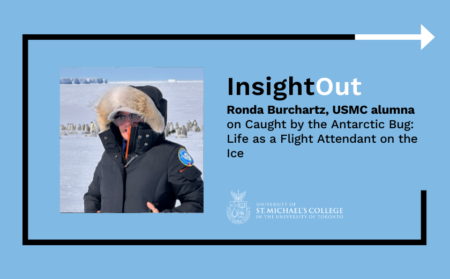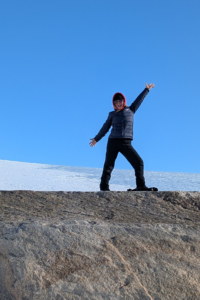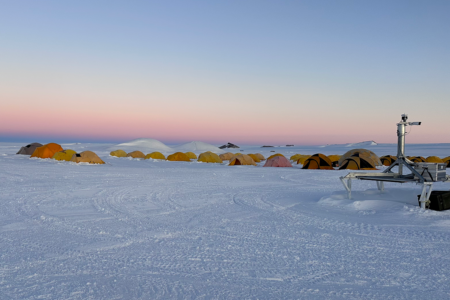Hi, my name is Ronda Burchartz. I feel truly blessed to have earned my Master of Religious Education degree from the Faculty of Theology at University of St. Michael’s College, University of Toronto. My journey has taken me through many roles/responsibilities—student, truck driver, fitness instructor, teacher, and now a flight attendant for adventure travellers and scientists. But beyond any title, Who I am is created by Love, to Love, for Love. I strive to bring that spirit into every role/responsibility: as a daughter, wife, mother, service provider, caregiver, friend, student or colleague. My Master’s studies helped me understand that our essence matters more than any title we hold. I hope the story below reflects that truth.
There’s cold, and then there’s Antarctica. My office is a plane, my home is a tent on a glacier, and my job as a flight attendant takes me to some of the most extreme places on Earth. But once the Antarctic Bug bites, there’s no going back—you find yourself drawn to the ice over and over again.

Flying in the Harshest Conditions
Being a flight attendant in Antarctica is nothing like other commercial aviation; it is more personal, and one must be ready for anything. Our flights depend on the weather, with brutal winds and icy runways making every journey unpredictable. There are no luxury lounges or in-flight entertainment—just a crew that depends on each other for everything, from safety to sanity.
Landing in the middle of a vast, white expanse never loses its magic. The ice stretches endlessly, shimmering under the 24-hour sun that never sets. But as breathtaking as it is, this environment is unforgiving. When we land, there are no terminals—just a frozen runway and the realization that we’re in one of the most remote places on the planet.
The guests depend on us when landing in these conditions. They look to us for reassurance, especially when touching down on snow-covered runways using skis. Sometimes, the landings are hard or bumpy, and guests glance back at me as if to ask, “Is everything okay?” I reassure them it is, and once we stop and step outside, they’re grateful to have had such a skilled crew looking after them.
The aircraft cabin is my home away from home. When guests come on board, I treat them as guests in my home—offering hot drinks and snacks and listening to their incredible stories. The people we meet are fascinating, and I am grateful for the opportunity to host so many outstanding individuals. One time, we were hosting a group when one of their family members fell ill back home. I offered comfort with hot drinks, and one of the guests asked me to lead a prayer circle for them. At that moment, I felt like part of their family. Their warmth and kindness stayed with me—I hope to meet them again.
Life on a Glacier

When not flying, we live in tents on the ice, completely exposed to the elements. The wind howls relentlessly, rattling our temporary homes, and the cold seeps into everything. But despite the harsh conditions, our tents are our refuge and sanctuary. There’s a sense of camaraderie that makes it all worth it. Our crew is more than just a team—we are a family, looking out for one another in one of the harshest environments imaginable.
We rely on each other not only for survival but also for emotional support. When we have losses at home that we cannot return for, we listen to and care for each other. One of our dear friends lost his mother the day he arrived, and there was no way to get him home for a month. So, we helped him by listening to his stories and being someone, he could count on. In such an isolated place, these small acts of kindness mean everything.
Simple things, like sharing a hot drink or swapping stories after a long day, become moments of warmth in the freezing cold. The Antarctic has a way of forging unbreakable bonds, which keeps many of us returning.
Meeting the People Who Call Antarctica Home

One of the most fascinating parts of this job is meeting the people who choose to live and work here for one year to eighteen months on the ice. Our flights take us to scientific bases where researchers dedicate their lives to studying Antarctica’s ice, climate, and unique wildlife. These scientists and explorers have an undeniable passion for the continent, and their stories are as awe-inspiring as the landscapes around us.
Our trips include flying to Atka Bay to see the emperor penguins—I can see these majestic birds at least seven times each season. On these trips, we’ve had the privilege of watching baby emperor penguins huddle together for warmth, their fluffy bodies braving the elements. It’s moments like these that make the hardships worth it—the chance to witness nature at its purest and most untouched.
Our team also flies to the South Pole at least five times per season. It is brutally cold there, and on the way back to our tents at Wolf’s Fang, we must stay at Dixie Camp for the night in unheated tents, where the temperature is never warmer than -20°C. Undressing and getting into the sleeping bag on those nights is a struggle, but once inside, we are toasty warm. Then we must get out in the morning… brrrr!
The Call of the Ice
Despite the extreme cold, the relentless winds, and the isolation, there’s something about Antarctica that gets under your skin. The sheer vastness, the beauty, the adventure—it all calls you back. Many of us come here thinking it’ll be a once-in-a-lifetime experience, only to find ourselves returning year after year.
That’s the power of the Antarctic Bug. Once it bites, you’re hooked for life.
Read other InsightOut posts.
